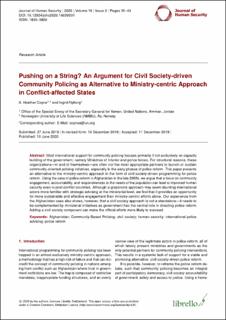| dc.contributor.author | Coyne, A. Heather | |
| dc.contributor.author | Nyborg, Ingrid L. P. | |
| dc.date.accessioned | 2021-11-04T11:26:02Z | |
| dc.date.available | 2021-11-04T11:26:02Z | |
| dc.date.created | 2021-01-19T16:07:37Z | |
| dc.date.issued | 2020 | |
| dc.identifier.citation | Journal of Human Security (JHS). 2020, 16 (2), 31-43. | |
| dc.identifier.issn | 1835-3800 | |
| dc.identifier.uri | https://hdl.handle.net/11250/2827833 | |
| dc.description.abstract | Most international support for community policing focuses primarily if not exclusively on capacity building of the government, namely Ministries of Interior and police forces. For structural reasons, these organizations—in and of themselves—are often not the most appropriate partners to launch or sustain community-oriented policing initiatives, especially in the early phases of police reform. This paper presents an alternative to the ministry-centric approach in the form of civil society-driven programming for police reform. Using the case of police reform in Afghanistan in the late 2000s, we argue that a focus on community engagement, accountability, and responsiveness to the needs of the population can lead to improved human security even in post-conflict countries. Although a grassroots approach may seem daunting international actors more familiar with strategic advising at the ministerial level, we find that it provides an opportunity for more sustainable and effective engagement than ministry-centric efforts alone. Our experience from the Afghanistan case also shows, however, that a civil society approach is not a standalone—it needs to be complemented by ministerial initiatives as government has the central role in directing police reform. Adding a civil society component can make the official efforts more likely to succeed. | |
| dc.language.iso | eng | |
| dc.title | Pushing on a string? An argument for civil society-driven community policing as alternative to ministry-centric approach in conflict-affected states | |
| dc.type | Peer reviewed | |
| dc.type | Journal article | |
| dc.description.version | publishedVersion | |
| dc.source.pagenumber | 31-43 | |
| dc.source.volume | 16 | |
| dc.source.journal | Journal of Human Security (JHS) | |
| dc.source.issue | 2 | |
| dc.identifier.doi | 10.12924/johs2020.16020031 | |
| dc.identifier.cristin | 1874628 | |
| dc.relation.project | EC/H2020/653909 | |
| cristin.ispublished | true | |
| cristin.fulltext | original | |
| cristin.qualitycode | 1 | |
